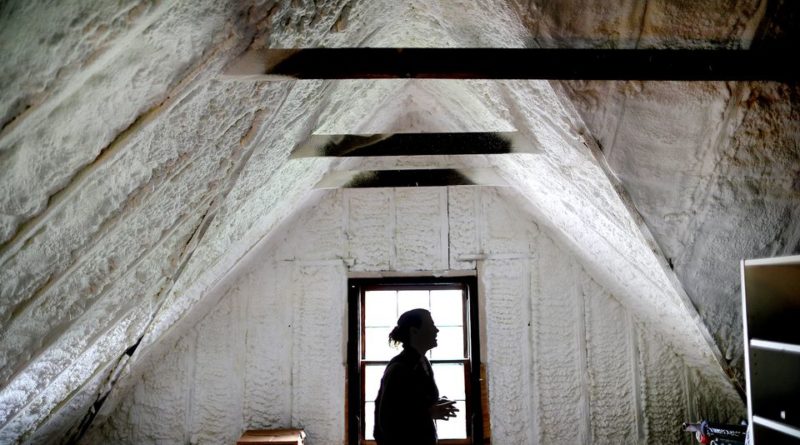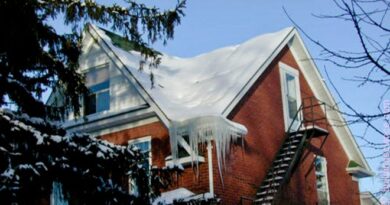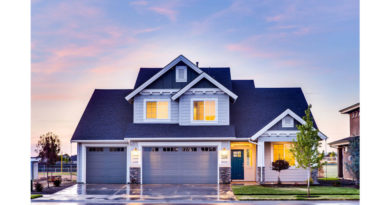A step-by-step guide to making an old New England home energy-efficient – The Boston Globe
Energy Disrupter
Advertisement
Getting an old home to net-zero isn’t always a reasonable goal, said Stephanie Horowitz, managing director at ZeroEnergy Design in Boston. But fully electrifying a home and investing in renewable power, such as a large-scale community solar project, can be just as impactful. “The goal is to decarbonize the home, to decouple it from fossil fuels, and to make it as efficient and comfortable and livable as possible,’’ Horowitz said.
The important thing with an existing home, she said, is to do everything you can to tighten up the building envelope first before you switch to all-electric systems. That will improve your comfort and also reduce the size of the heating system needed.
Mike Panis and Kathleen Finn understand the sometimes-elusive quest for comfort in a historic home. When the couple purchased their 1888 Victorian in Somerville in 2004, the windows were a struggle to open. “The house was drafty, so we focused more on comfort [initially],’’ Panis said. Working with Cambridge contractor Charlie Allen Renovations, they’ve been careful to preserve the home’s historic character while making incremental efficiency improvements that dovetailed with other projects, such as installing central air and remodeling a bathroom.
Advertisement
Horowitz and Charlie Allen Renovations project developer Mark Philben, the author behind the Globe’s “Ask the Remodeler” feature, toured the house with Panis to review what’s been done so far and explore what other improvements could get the home closer to net-zero.

Attic and Basement Insulation
“The most important part is the top of the house,’’ said Jason Taylor, an air-sealing specialist with Byggmeister Associates and an instructor at Green Jobs Academy. If heat is escaping into the attic, the resulting negative pressure downstairs will pull cold air into the first floor.
A Boston-area attic should be insulated to R-49 to keep conditioned air in the living space below, where it belongs. In most attics, that involves sealing all air leaks in the attic floor — including hard-to-reach ones behind chimneys, knee walls, and dormers — and laying down a thick layer of mineral wool or cellulose insulation.
If the attic is or will be used as living space, spray foam insulation can be applied to the rafters, which essentially brings the attic itself (and any ductwork within it) into the conditioned living area. On this Somerville house, Philben’s crew used closed-cell spray foam, which provides more insulating R-value per inch than open-cell spray foam, and also acts as an air sealer to plug any leaks. Since the foam is exposed, it was treated with a fire retardant coating.
Advertisement
Some spray foams have a huge climate footprint, so Horowitz suggested that homeowners insist that their contractors use a spray-foam product with a low global warming-potential (GWP) blowing agent. “There are some foams that are pretty benign in terms of their blowing agent and others that are pretty nasty and do a fair amount of damage,’’ she said.
Philben’s crew also applied closed-cell spray foam to the rim joists around the perimeter of the basement. “All the way around where the foundation meets the sill beam that the house is built on is one of the worst areas for drafts,’’ he said.
■ COST Insulating and air sealing an empty, flat, 1,000-square-foot attic costs about $3,000 (before Mass Save discounts of 75 percent to 100 percent), Taylor estimated, and can shave about 20 percent off your heating bill. Applying closed-cell spray foam with flame retardant is a lot more expensive: about $8 to $10 per square foot of the roof, he estimated.
Blower Door Test
Sealing any leaks or gaps where conditioned air escapes is a critical step to ensuring a home’s efficiency and comfort. Common culprits include the areas around chimneys, windows, recessed lights, stink pipes, and wet walls, Taylor said. But there are always more leaks, and a blower door test is the best way to find them and to check that they’ve been properly sealed.
To do this, Taylor places a high-powered fan and pressure gauge in the downstairs door and tightly seals the rest of the doorway with plastic to create a pressurized environment inside the home. Then, up in the attic, he uses a smoke wand — imagine a device like a vape pen or an electronic incense stick — and follows the smoke trails to see where air is getting out.
Advertisement
After sealing those gaps, Taylor runs a zonal pressure diagnostic test. By comparing the air pressure at the blower door with the readings upstairs, he can see exactly how much air is being lost. Some quick arithmetic, he said, “gives you the approximate number of square inches of holes that are in the air barrier.’’ A bunch of small leaks can add up, leaving your home with a collective hole the size of an open window.
■ COST Professional air sealers should perform this test as part of their service. New England HERS Rater charges about $350 for a blower door test and infrared camera scan.
Walls
Rigid foam board installed under new siding can add a bit of R-value to a home’s exterior, but dense-pack cellulose blown inside the wall cavities provides the best insulation. When it’s cold outside and warm inside, an infrared camera can reveal crucial clues about which walls are allowing heat to escape. “The IR camera tells you where insulation is missing,” Taylor said.
“Everything shows up blue where your leaks are,” Philben said. “The baseboards are glowing blue, and there’s blue around the door, and you literally can see inside the walls. You can see where there isn’t insulation,” Philben said.
Advertisement
The walls in Panis and Finn’s house were partially insulated — a half-measure both Taylor and Horowitz recommend addressing — because whoever installed blown-in insulation years ago didn’t do a thorough job. “You find blocking in the walls — these diagonal wind braces that they used to put on when they did the framing to give it structural support,” Philben said. “And if you don’t know what you’re doing, you’ll fill the top half but not the bottom half.”
Like a cold front swooping in, an uninsulated wall can create its own type of uncomfortable breeze in a room, Horowitz explained. “You’re going to get this cycling of air that starts to feel like a draft, when the temperature at the exterior of the home is colder than it is further in,” she said.
■ COST Blowing insulation into empty walls can cost $2,500 per 1,000 square feet, Taylor said, and more for asbestos or aluminum siding. But Mass Save covers much of the cost for eligible residents — in fact, Mass Save will now cover 100 percent of the cost for tenants and landlords of 2-, 3-, and 4-family buildings if every unit is done at once — and Taylor estimates it can shave 18 percent off heating bills.

Siding
There are two layers of wood siding on Panis and Finn’s house, the outermost in decent but degrading condition. Since all building materials eventually wear out, Horowitz said it’s good to start thinking about inevitable next steps well in advance.
“If the siding has reached the end of its useful lifespan, we’ll strip it off, install an exterior air barrier, wrap the house with a rigid insulation, and then re-side it with a rain screen that will help preserve the lifespan of the new siding,” Horowitz said. Using a peel-and-stick membrane for the air and weather barrier improves overall air-tightness, she said, because it creates a continuous surface that ties into the windows, the top of the foundation, and the roof.
Adding rigid foam, plus a Cedar Breather layer that allows wood shingles to drain and dry out, adds a few inches of depth to the walls, which can interfere with historic details such as window trims, Horowitz noted — so sometimes blown-in insulation has to suffice. “We don’t have to wrap every house in exterior insulation. I certainly like to, but we don’t have to.”
■ COST Installing new cedar siding on a Victorian, with a membrane and rigid foam, can easily cost $200,000-$250,000, Philben said.



Storm Windows
Antique windows constructed from dense old-growth wood can last for centuries if restored to good working order. But single-pane glass hemorrhages heat, so snug weather-stripping and a storm window — whose second glass pane creates an insulating air pocket — are a must.
Panis said he is waiting on a custom-built storm window for the stained-glass window in the stairway. But in 2017, Charlie Allen Renovations replaced most of the ill-functioning storms with Harvey TruChannel storm windows. (Harvey was bought out, so the closest equivalent available today is the ProVia, Philben said.)
The slim, black aluminum frames are contextually appropriate and approved by most historic commissions. “Back in the day, everything would have been either a black window, or you see hunter green a lot,” Philben said. “So we would paint the outside of the sash black and put on a black storm window.”
■ COST Restoring and weather stripping a pre-1960 double-hung window costs a few hundred dollars per window, according to Alison Hardy, owner of Window Woman of New England in Amesbury. Adding an aluminum storm window will cost upward of $600 installed, said Greg Caplan, a sustainable home expert at Boston Building Resources.

Heat Pump [outdoor unit]
An air-source heat pump is the key to electrifying a home’s heating system (not to mention adding central air to an old home without ductwork). Panis had central air installed in the attic, and running ducts down to the first floor was something of a challenge (Philben used a chimney chase and reclaimed closet space). But a heat pump could be split between the attic and the basement, with the lower unit sending hot or cool air up through floor grates in the first floor and the attic unit servicing the upstairs bedrooms.
If done in tandem with another renovation, you can run a heat pump’s refrigerant lines through the walls so you don’t end up with a downspout-style encasement on the home’s exterior.
■ COST A whole-home heat pump can cost upward of $20,000 installed, according to Massachusetts Clean Energy Center, but current Mass Save rebates can knock $10,000 off that price.
Related
Everything you need to know about adding heat pumps to your home
Sometimes solar panels are not a good fit for your home. Here’s why.
Green Living: Eco-friendly building terms explained
After fits and starts, community solar is going mainstream. Here’s how to get in on it.
Heat Pump Water Heater
A hot water heater accounts for about a fifth of a home’s energy use, according to Energy.gov. More efficient heat pump water heaters — sometimes called “hybrid” water heaters, because they rely on traditional electric resistance as a backup heat source when necessary — use heat pump technology, moving heat around instead of creating it through combustion. They’re best used in unfinished basements, since they will cool the surrounding area as they absorb and transfer the ambient heat.
■ COST A heat pump water heater can cost up to $3,500 installed, according to “This Old House.”
Update Electric Service
Many older homes still have 100-amp circuit breakers, but if you’re planning to electrify your entire home — and possibly charge an electric car, too — you’ll want a licensed electrician to upgrade your home to 200-amp service.
■ COST Typically between $2,500 and $4,500, according to the Massachusetts Clean Energy Center.
Induction Stove
Aside from using fossil fuel, gas stoves can also affect indoor air quality, increasing the risk of asthma or other respiratory ailments in children. Cooks accustomed to gas, though, will find that new induction cooktops — which use magnetic currents to heat the cookware instantly — rival the responsiveness of a gas flame.
■ COST While a traditional electric stove costs about the same as a gas model, starting at around $600, induction stoves cost upward of $1,200 — and you may need to invest in some new cast-iron or stainless steel cookware as well.
Solar Panels
The ultimate key to achieving net-zero status is fully electrifying the home and then producing enough solar electricity on site to power those systems. That is where luck and layout play a big role: Even a very inefficient house can reach net-zero if enough solar panels fit on top of it.
Panis said he explored installing rooftop solar panels but found the roof wasn’t a great fit. However, purchasing community solar or 100 percent renewable power through the Green Energy Consumers Alliance can achieve a similar result, even if it’s off-site.
■ COST The average cost of installing a 7-kilowatt solar array in Massachusetts is about $16,000 after federal tax credits, according to solar marketplace EnergySage.
Jon Gorey blogs about homes at HouseandHammer.com. Send comments to jongorey@gmail.com. Follow him on Twitter at @jongorey. Subscribe to our newsletter at pages.email.bostonglobe.com/AddressSignUp. Follow us on Twitter @globehomes.
Original Source: https://www.bostonglobe.com/2022/06/12/real-estate/step-by-step-guide-making-an-old-new-england-home-energy-efficient/















